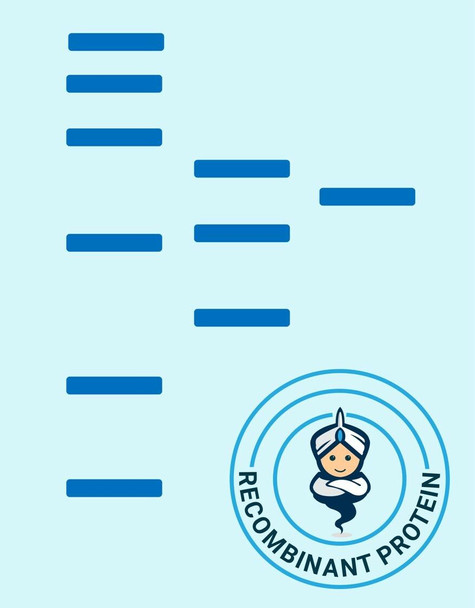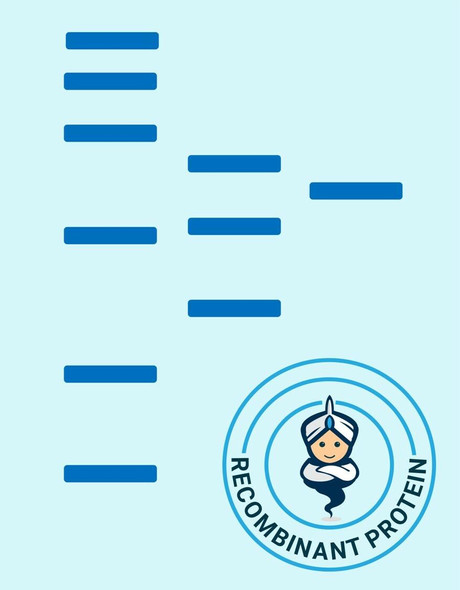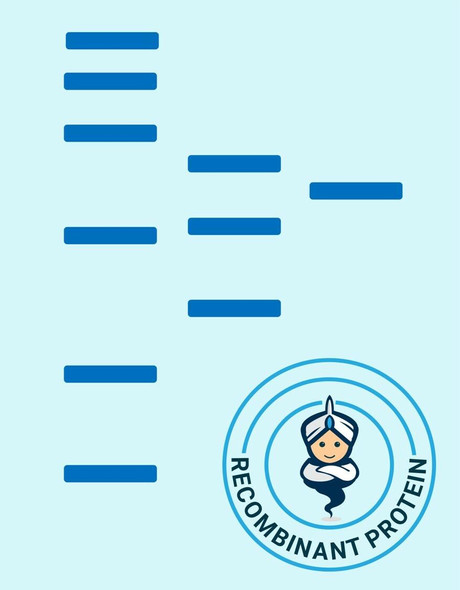Mouse SDF 1a Recombinant Protein (RPPB1249)
- SKU:
- RPPB1249
- Product Type:
- Recombinant Protein
- Species:
- Mouse
- Uniprot:
- P40224
- Research Area:
- Chemokines
Description
| Product Name: | Mouse SDF 1a Recombinant Protein |
| Product Code: | RPPB1249 |
| Size: | 10µg |
| Species: | Mouse |
| Target: | SDF 1a |
| Synonyms: | SDF-1, CXCL12, Pre-B cell growth-stimulating factor,PBSF, hIRH, chemokine (C-X-C motif) ligand 12, SDF1, SDF1A, TPAR1, SCYB12,SDF-1a, TLSF-a, 12-O tetradecanoylphorbol 13-acetate repressed protein 1,Thymic lymphoma cell stimulating factor, TLSF. |
| Source: | Escherichia Coli |
| Physical Appearance: | Sterile Filtered colorless solution. |
| Formulation: | SDF 1a protein solution (0.25mg/ml) containing PhosphateBuffered Saline (pH7.4) and 10% glycerol. |
| Stability: | Store at 4°C if entire vial will be used within 2-4 weeks. Store, frozen at -20°C for longer periods of time. For long term storage it is recommended to add a carrier protein (0.1% HSA or BSA).Avoid multiple freeze-thaw cycles. |
| Purity: | Greaterthan 95.0% as determined by SDS-PAGE. |
| Amino Acid Sequence: | MGSSHHHHHH SSGLVPRGSH MGSKPVSLSY RCPCRFFESH IARANVKHLK ILNTPNCALQ IVARLKNNNR QVCIDPKLKW IQEYLEKALN K |
SDF-1 (stromal cell-derived factor-1) is small cytokine belonging to the chemokine family that is officially designated Chemokine (C-X-C motif) ligand 12 (CXCL12). It is produced in two forms, CXCL12a and CXCL12b, by alternate splicing of the same gene. Chemokines are characterized by the presence of four conserved cysteines, which form two disulfide bonds. The CXCL12 proteins belong to the group of CXC chemokines, whose initial pair of cysteines are separated by one intervening amino acid. CXCL12 is strongly chemotactic for lymphocytes and has been implicated as an important cell co-ordinator during development. During embryogenesis it directs the migration of hematopoietic cells from foetal liver to bone marrow. Mice which were knocked-out for CXCL12 gene were lethal before the birth or within just 1 hour of life. As another role, CXCL12a alters also the electrophysiology of neurons. CXCL12 was shown to be expressend in many tissues in mice (including brain, thymus, heart, lung, liver, kidney, spleen and bone marrow).The receptor for this chemokine is CXCR4, which was previously called fusin. This CXCL12-CXCR4 interaction used to be considered exclusive (unlike for other chemokines and their receptors), but recently it was suggested that CXCL12 is also bound by CXCR7 receptor.The gene for CXCL12 is located on human chromosome 10. In human and mouse both CXCL12 and CXCR4 show high identity of sequence: 99% and 90%, respectively.
SDF 1a Mouse Recombinant produced in E.Coli is a single,non-glycosylated polypeptide chain containing 91 amino acids (22-89 a.a) andhaving a molecular mass of 10.4kDa. SDF 1a is fused toa 23 amino acid His-tag at N-terminus & purified by proprietarychromatographic techniques.
| UniProt Protein Function: | CXCL12 iso3: Chemoattractant active on T-lymphocytes, monocytes, but not neutrophils. Activates the C-X-C chemokine receptor CXCR4 to induce a rapid and transient rise in the level of intracellular calcium ions and chemotaxis. Also binds to another C-X-C chemokine receptor CXCR7, which activates the beta-arrestin pathway and acts as a scavenger receptor for SDF-1. SDF-1-beta(3-72) and SDF-1- alpha(3-67) show a reduced chemotactic activity. Binding to cell surface proteoglycans seems to inhibit formation of SDF-1-alpha(3- 67) and thus to preserve activity on local sites. Acts as a positive regulator of monocyte migration and a negative regulator of monocyte adhesion via the LYN kinase. Stimulates migration of monocytes and T-lymphocytes through its receptors, CXCR4 and CXCR7, and decreases monocyte adherence to surfaces coated with ICAM-1, a ligand for beta-2 integrins. SDF1A/CXCR4 signaling axis inhibits beta-2 integrin LFA-1 mediated adhesion of monocytes to ICAM-1 through LYN kinase. Inhibits CXCR4-mediated infection by T- cell line-adapted HIV-1. Plays a protective role after myocardial infarction. Induces down-regulation and internalization of CXCR7 expressed in various cells. Has several critical functions during embryonic development; required for B-cell lymphopoiesis, myelopoiesis in bone marrow and heart ventricular septum formation. Monomer or homodimer; in equilibrium. Dimer formation is induced by non acidic pH and the presence of multivalent anions, and by binding to CXCR4 or heparin. Monomeric form is required for full chemotactic activity and resistance to ischemia/reperfusion injury, whereas the dimeric form acts as a partial agonist of CXCR4, stimulating Ca2+ mobilization but with no chemotactic activity and instead acts as a selective antagonist that blocks chemotaxis induced by the monomeric form. Interacts with the N- terminus of CXCR7. Isoform Alpha and isoform Beta are ubiquitously expressed, with highest levels detected in liver, pancreas and spleen. Isoform Gamma is mainly expressed in heart, with weak expression detected in several other tissues. Isoform Delta, isoform Epsilon and isoform Theta have highest expression levels in pancreas, with lower levels detected in heart, kidney, liver and spleen. Belongs to the intercrine alpha (chemokine CxC) family. 6 isoforms of the human protein are produced by alternative splicing. |
| UniProt Protein Details: | Protein type:Cell development/differentiation; Secreted, signal peptide; Motility/polarity/chemotaxis; Secreted; Chemokine Cellular Component: extracellular space; plasma membrane; extracellular region; external side of plasma membrane Molecular Function:growth factor activity; chemokine receptor binding; chemokine activity; CXCR chemokine receptor binding; cytokine activity Biological Process: positive regulation of dopamine secretion; organ regeneration; positive regulation of cell adhesion; adult locomotory behavior; neuron migration; motor axon guidance; regulation of calcium ion transport; chemotaxis; regulation of cell migration; germ cell development; induction of positive chemotaxis; T cell proliferation; patterning of blood vessels; ameboidal cell migration; positive regulation of cell proliferation; germ cell migration; positive regulation of axon extension involved in axon guidance; positive regulation of endothelial cell proliferation; immune response; brain development; positive regulation of neuron differentiation; telencephalon cell migration; positive regulation of cell migration |
| NCBI Summary: | This gene encodes a member of the alpha chemokine protein family. The encoded protein is secreted and functions as the ligand for the G-protein coupled receptor, chemokine (C-X-C motif) receptor 4. The encoded protein plays a role in many diverse cellular functions, including embryogenesis, immune surveillance, inflammation response, tissue homeostasis, and tumor growth and metastasis. Alternative splicing results in multiple transcript variants. [provided by RefSeq, May 2013] |
| UniProt Code: | P40224 |
| NCBI GenInfo Identifier: | 251757334 |
| NCBI Gene ID: | 20315 |
| NCBI Accession: | P40224.2 |
| UniProt Secondary Accession: | P40224,Q4FJL5, Q543V6, |
| UniProt Related Accession: | P40224 |
| Molecular Weight: | 10,032 Da |
| NCBI Full Name: | Stromal cell-derived factor 1 |
| NCBI Synonym Full Names: | chemokine (C-X-C motif) ligand 12 |
| NCBI Official Symbol: | Cxcl12�� |
| NCBI Official Synonym Symbols: | Pbsf; Sdf1; Tlsf; Tpar1; Scyb12�� |
| NCBI Protein Information: | stromal cell-derived factor 1; pre-B-cell growth-stimulating factor; thymic lymphoma cell-stimulating factor; 12-O-tetradecanoylphorbol 13-acetate repressed protein 1 |
| UniProt Protein Name: | Stromal cell-derived factor 1 |
| UniProt Synonym Protein Names: | 12-O-tetradecanoylphorbol 13-acetate repressed protein 1; TPAR1; C-X-C motif chemokine 12; Pre-B cell growth-stimulating factor; PBSF; Thymic lymphoma cell-stimulating factor; TLSF |
| UniProt Gene Name: | Cxcl12�� |
| UniProt Entry Name: | SDF1_MOUSE |










